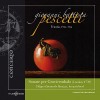Biography
The popular Sonata in C minor was transcribed for harp by Carlos Salzedo. The first movement is in two four and opens with eighth notes outlining the tonic triad—C, down a fourth to G, up a sixth to E Flat and back down a third to C. This is echoed in the left hand as the right hand plays quarter notes E flat, C, B natural. The right hand now plays the melody again and continues on, transposing to G major, going through a short development and then ending in G. The melody repeats, then goes to a second section starting in E flat major. This section follows the same structure—melody in right hand, melody in left hand, melody in right hand, transposes back to c minor, goes through the same development and then ends in c minor. The second section repeats again and the movement ends.
The second movement in characterized by a quarter note melody embellished by grace notes with a triplet left hand accompaniment.
The third movement (presto) begins with the three notes of the C minor triad in a C-G-C-E flat pattern. This upwards moving passage then moves down from E flat to C then repeats the opening pattern with different notes, D-G-D-F and then descends from F to D and then returns to E flat. In order to complete this opening passage there is a downwards scale from E- flat to C and then leave the opening in a state of resolution, there is a final four note pattern, B natural-C-D and finally to G, the dominant. This is then repeated an octave lower. Throughout this, the left hand is playing short, staccato accompanying quarter notes whereas the right, which was discussed above, is playing eighth note tuplet. After the opening passage is complete, there is the a series of broken C major chords one octave above from where the opening passage ended. Each of these broken chords are repeated twice, modulating from C major to F minor to B flat major and finally, to E flat major. Once reaching E flat major, the relative major of C minor, there is a downwards scale continuing until reaching G, an octave lower. From this point, a new pattern emerges, consisting of the three notes: F, G, A flat and B flat. The notes are arranged in a G-A flat-B flat F-G-A flat pattern, which is repeated twice. After this pattern, a broken E flat major tonic chord is played, followed by another downwards scale once again beginning on C and continuing to a low F. Following the scale is a final closing pattern, one which is not heard in again in the piece. The closing bar ends with a broken E flat major chord beginning on G followed by the three notes C - A flat - G and closes in a E flat major cadence. (End of first part.)









